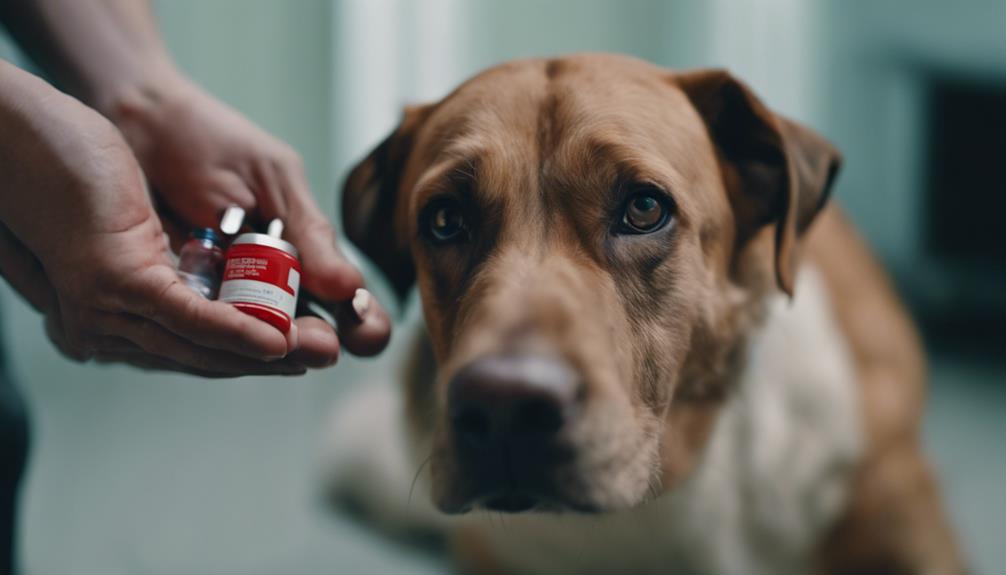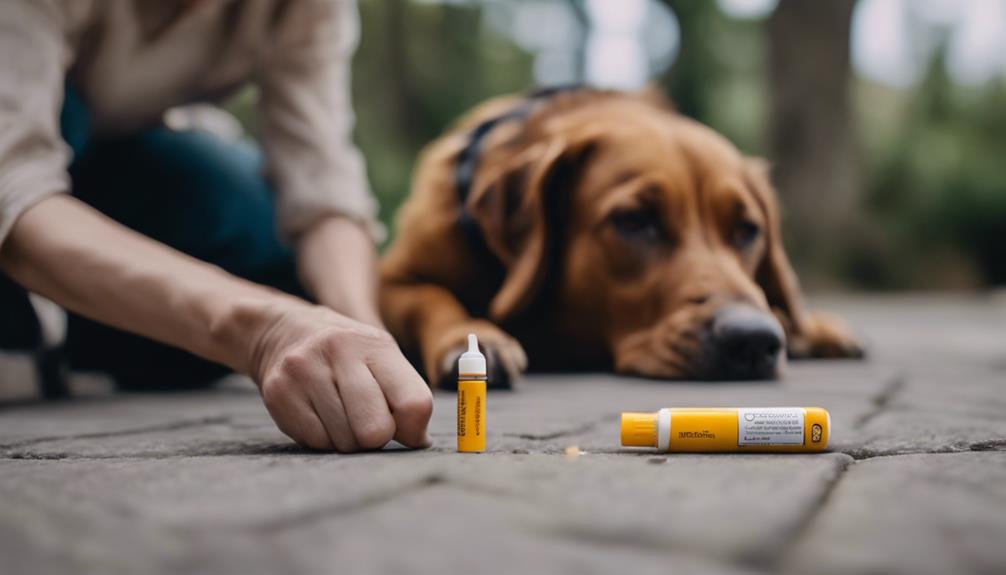Understanding the subtle cues that may indicate an allergic reaction in your dog is a crucial aspect of responsible pet ownership. From subtle changes in behavior to visible physical symptoms, being able to discern these signs promptly can be a lifesaving skill for any dog owner.
As we navigate the complexities of canine health, it becomes imperative to equip ourselves with the knowledge necessary to address allergic reactions effectively. Stay tuned to discover the key indicators of an allergic response in your furry friend and the essential steps to take in ensuring their well-being.
Key Takeaways
- Watch for skin welts, itching, and facial swelling.
- Manage swelling with cold compress and vet-approved medication.
- Address flea allergies promptly with prednisone and vet guidance.
- React quickly to severe reactions, seek vet help, and prevent further exposure.
Recognizing Swelling Symptoms
Swelling symptoms in dogs can be indicative of various underlying causes, ranging from insect bites to post-vaccination reactions. It is important to monitor your dog for signs of swelling, especially around the face, muzzle, or paws. If your dog experiences difficulty breathing or swallowing, immediate veterinary attention is crucial.
To provide relief at home, you can apply a cold compress to the affected area and administer diphenhydramine under veterinary guidance. Prevent your dog from pawing at the swollen areas to avoid further irritation.
Timely identification and appropriate management of swelling symptoms can help prevent potential complications and ensure your dog's well-being.
Identifying Hives and Allergic Reactions
Upon encountering hives and allergic reactions in dogs, swift and accurate identification is imperative for prompt and effective treatment.
- Look for raised, red welts on the skin
- Monitor for sudden itching or discomfort
- Check for facial swelling, especially around the eyes and muzzle
- Observe for signs of respiratory distress such as coughing or wheezing
- Seek veterinary guidance if symptoms persist or worsen
Understanding Flea Allergies and Itchy Welts

Flea allergies in dogs can cause itchy welts, typically appearing near the tail and potentially spreading throughout the body if left untreated. These welts are a common sign of an allergic reaction to flea saliva. The best approach to managing flea allergies is through a combination of treatment for the dog and the environment to eliminate the source of the fleas. Here is a visual representation of the key points related to flea allergies and itchy welts:
| Flea Allergies and Itchy Welts | |
|---|---|
| Symptoms | Raised itchy welts near the tail |
| Treatment | Prednisone |
| Prevention | Treat all pets and environment for fleas |
| Action | Contact vet for a proper treatment plan |
Reacting to Anaphylaxis and Severe Reactions
Severe allergic reactions in dogs, such as anaphylaxis, require immediate veterinary attention to prevent serious consequences. If you suspect your dog is experiencing anaphylaxis or a severe allergic reaction, here are some crucial steps to take:
- Rush your dog to the nearest veterinary clinic without delay.
- Contact the vet en route to inform them of the situation.
- Do not attempt to administer any medications without professional guidance.
- Keep your dog calm and try to prevent them from further exposure to the allergen.
- Be prepared to provide details about the potential trigger to aid in quick and accurate treatment.
Managing Insect Bite Reactions

When addressing insect bite reactions in dogs, immediate action is crucial to alleviate symptoms and prevent potential complications. Insect bites, such as those from wasps or bees, can lead to swelling and discomfort in dogs. To manage insect bite reactions effectively, it is important to prevent the dog from pawing at the affected area and to seek veterinary care promptly if breathing problems arise. Using a cold compress and diphenhydramine can help provide relief from swelling and itching. Below is a table summarizing key points for managing insect bite reactions in dogs:
| Action | Description |
|---|---|
| Prevent pawing | Stop the dog from scratching or licking the bite |
| Cold compress | Apply a cold compress to reduce swelling |
| Diphenhydramine | Administer antihistamine for itch relief |
| Veterinary care | Seek immediate vet attention for severe reactions |
| Monitor breathing | Watch for signs of breathing difficulties |
Dealing With Post-Vaccination Swelling
Managing post-vaccination swelling in dogs requires prompt attention and appropriate measures to alleviate any discomfort and monitor for potential complications. Here are some steps to help deal with post-vaccination swelling:
- Keep the dog calm and prevent excessive activity to reduce inflammation.
- Apply a cold compress to the swollen area to help decrease swelling.
- Monitor the swelling for any signs of progression or additional symptoms.
- Contact your veterinarian for further guidance and to determine if any additional treatment is necessary.
- Avoid giving any medications without veterinary approval to prevent adverse reactions or interference with the vaccination's effectiveness.
Treating Hives With Diphenhydramine

After addressing post-vaccination swelling, the next crucial step involves understanding the treatment of hives using diphenhydramine. Hives, characterized by raised, red, and itchy welts on the skin, can be caused by various allergens, including insect bites or plant allergies.
When hives occur, administering diphenhydramine, commonly known as Benadryl, can help alleviate symptoms such as itching and discomfort in dogs. Diphenhydramine works by blocking histamine, a substance in the body that causes allergic reactions. However, it's important to note that diphenhydramine may not always be sufficient for severe cases of hives.
If the hives persist or worsen, it is advisable to consult a veterinarian for further evaluation and potential alternative treatments, such as corticosteroids like prednisone.
Using Corticosteroids for Severe Cases
Corticosteroids play a crucial role in managing severe allergic reactions in dogs.
- Corticosteroids like prednisone are often prescribed for severe allergic reactions.
- They work by reducing inflammation and suppressing the immune response.
- Corticosteroids can help alleviate symptoms such as swelling, itching, and hives quickly.
- These medications are usually given for a short period to avoid long-term side effects.
- It is essential to follow the vet's instructions carefully when administering corticosteroids to your dog during a severe allergic reaction.
Addressing Flea Allergies Near the Tail

When addressing flea allergies near the tail in dogs, it is crucial to closely monitor for raised, itchy welts as they can be indicative of a significant allergic reaction. These welts may lead to discomfort and distress for your canine companion. It is important to take prompt action to relieve your dog's symptoms and prevent further complications. Below is a table outlining key steps to address flea allergies near the tail effectively:
| Addressing Flea Allergies Near the Tail | Actions |
|---|---|
| Monitor for raised, itchy welts | Watch for signs of discomfort |
| Check for fleas and flea dirt | Inspect dog's fur regularly |
| Use flea treatment products | Consult with a vet for advice |
| Keep the tail area clean and dry | Prevent secondary infections |
| Consider preventive measures | Protect against future flea infestations |
Administering Prednisone for Flea Allergies
Considering the severity of flea allergies in dogs, the administration of prednisone plays a crucial role in alleviating symptoms and managing the allergic reaction effectively. Prednisone is a commonly prescribed corticosteroid that can help reduce inflammation and itching associated with flea allergies.
Here are some key points to keep in mind when administering prednisone for flea allergies:
- Consult a veterinarian before starting prednisone treatment.
- Follow the prescribed dosage and schedule strictly.
- Monitor your dog for any side effects such as increased thirst or urination.
- Do not abruptly stop the medication; follow the tapering instructions provided.
- Combine prednisone treatment with flea control measures for comprehensive management.
Handling Anaphylactic Emergencies

In cases of severe allergic reactions in dogs, prompt and decisive action is crucial to handle anaphylactic emergencies effectively. Anaphylaxis is a serious condition that can lead to breathing difficulties, collapse, and even death if not treated promptly.
If you suspect your dog is experiencing an anaphylactic reaction, it is essential to seek immediate veterinary attention. Signs of anaphylaxis may include swollen muzzle, hives, difficulty breathing, vomiting, diarrhea, or collapse. While waiting for professional help, keep your dog calm and try to prevent further exposure to the allergen.
It's also advisable to have a custom epi pen for known severe allergies, as quick action is vital in these emergency situations to prevent serious consequences.
Preparing for Known Severe Allergies
To effectively manage known severe allergies in dogs, proactive measures must be taken to ensure quick and appropriate responses in emergency situations.
- Keep a custom epi pen on hand for immediate use
- Inform family members and pet sitters about the allergies and emergency procedures
- Consult with a veterinarian to create an allergy action plan
- Regularly monitor the dog for any signs of allergic reactions
- Have emergency contact numbers for vet clinics or animal hospitals readily available
Recognizing Signs of Allergic Reactions

When observing your dog for potential allergic reactions, vigilance and prompt recognition of symptoms are crucial for ensuring timely intervention. Allergic reactions in dogs can manifest in various ways, such as swelling, hives, itchiness, or even anaphylaxis. Swelling, often due to insect bites or post-vaccination, should be monitored closely, especially if it leads to breathing difficulties.
Hives, which appear and disappear rapidly, may signal an allergic reaction that requires attention beyond just antihistamines. Additionally, flea allergies can cause itchy welts near the tail and may necessitate treatment with corticosteroids. If your dog exhibits signs of anaphylaxis, like severe breathing problems or swollen muzzle, immediate veterinary care is crucial to prevent serious consequences.
Stay alert to these symptoms to protect your pet's health.
Exploring Additional Resources
Upon encountering potential allergic reactions in your dog, delving into additional resources can provide valuable insights and guidance for managing and addressing various allergy-related issues effectively. Here are some additional resources to help you navigate and handle allergic reactions in your furry friend:
- Online forums and communities: Connect with other pet owners who have experience dealing with dog allergies.
- Veterinary websites: Explore reputable websites that offer detailed information on pet allergies and treatment options.
- Allergy testing services: Consider professional allergy testing to identify specific triggers causing reactions in your dog.
- Local pet stores: Seek advice from knowledgeable staff regarding allergen-free products and remedies.
- Dog training classes: Learn techniques to prevent your dog from coming into contact with common allergens during outdoor activities.
Conclusion
In conclusion, recognizing and understanding the signs of allergic reactions in dogs is essential for their well-being.
By being able to identify symptoms such as swelling, hives, and anaphylaxis, pet owners can take appropriate steps to provide timely care and ensure the safety of their furry companions.
Being prepared for potential allergic challenges and knowing how to react in emergency situations can make a significant difference in the outcome for dogs facing allergic reactions.




